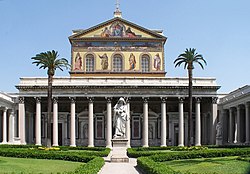Pope Hilarius was the bishop of Rome from 19 November 461 to his death on 29 February 468.
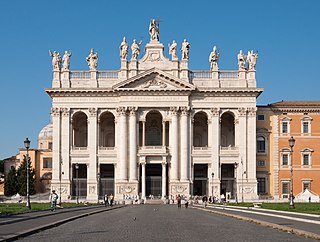
The Archbasilica Cathedral of the Most Holy Savior and of Saints John the Baptist and John the Evangelist in the Lateran, also known as the Papal Archbasilica of Saint John [in] Lateran, Saint John Lateran, or the Lateran Basilica, is the Catholic cathedral church of the Diocese of Rome in the city of Rome, and serves as the seat of the bishop of Rome, the pope. The archbasilica lies outside of Vatican City proper, which is located approximately 4 kilometres (2.5 mi) to the northwest. Nevertheless, as properties of the Holy See, the archbasilica and its adjoining edifices enjoy an extraterritorial status from Italy, pursuant to the terms of the Lateran Treaty of 1929. Laterano (Lateran) comes from an ancient Roman family (gens), whose palace (domus) grounds occupied the site; the Lateran Palace was the primary residence of the pope until the Middle Ages.

The Archdiocese of St. Louis is a Latin Church ecclesiastical territory or archdiocese of the Catholic Church that covers the City of St. Louis and the Missouri counties of Franklin, Jefferson, Lincoln, Perry, Saint Charles, Saint Francois, Ste. Genevieve, St. Louis, Warren, and Washington. It is the metropolitan see of the ecclesiastical province containing three suffragan sees: Diocese of Springfield-Cape Girardeau, the Diocese of Jefferson City, and the Diocese of Kansas City-Saint Joseph.
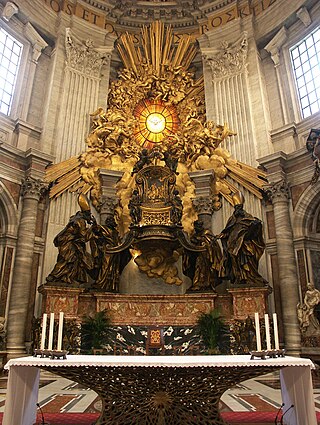
The Chair of Saint Peter, also known as the Throne of Saint Peter, is a relic conserved in St. Peter's Basilica in Vatican City, the sovereign enclave of the Pope inside Rome, Italy. The relic is a wooden throne that tradition claims belonged to the Apostle Saint Peter, the leader of the Early Christians in Rome and first Pope, and which he used as Bishop of Rome. The relic is enclosed in a sculpted gilt bronze casing designed by Gian Lorenzo Bernini and constructed between 1647 and 1653. In 2012, Pope Benedict XVI described the chair as "a symbol of the special mission of Peter and his Successors to tend Christ's flock, keeping it united in faith and in charity."

The Roman Catholic Diocese of Jackson is a Latin Church diocese in Mississippi in the United States. Its ecclesiastical jurisdiction includes the northern and central parts of the state, an area of 97,458 square kilometers (37,629 sq mi). It is the largest diocese, by area, east of the Mississippi River.
This article lists the feast days of the General Roman Calendar as they were at the end of 1954. It is essentially the same calendar established by Pope Pius X (1903–1914) following his liturgical reforms, but it also incorporates changes that were made by Pope Pius XI (1922–1939), such as the institution of the Feast of Christ the King, and the changes made by Pope Pius XII (1939–1958) prior to 1955, chief among them the imposition of the Feast of the Immaculate Heart of Mary upon the universal Church in 1944, the inscription of Pius X into the General Calendar following his 1954 canonization, and the institution of the Feast of the Queenship of Mary in October 1954.
The General Roman Calendar is the liturgical calendar that indicates the dates of celebrations of saints and mysteries of the Lord in the Roman Rite of the Catholic Church, wherever this liturgical rite is in use. These celebrations are a fixed annual date, or occur on a particular day of the week. Examples are the Feast of the Baptism of the Lord in January and the Feast of Christ the King in November.
"Octave" has two senses in Christian liturgical usage. In the first sense, it is the eighth day after a feast, reckoning inclusively, and so always falls on the same day of the week as the feast itself. The word is derived from Latin octava (eighth), with dies (day) understood. In the second sense, the term is applied to the whole period of these eight days, during which certain major feasts came to be observed.

San Thome Church, officially known as St Thomas Cathedral Basilica and National Shrine of Saint Thomas, is a minor basilica of the Catholic Church in India, at the Santhome neighbourhood of Chennai, in Tamil Nadu. The present structure dates to 1523 AD, when it was rebuilt by the Portuguese over the tomb of Thomas the Apostle. In 1896, it was renovated in the Madras province according to neo-Gothic designs, as was favoured by British architects in the late 19th century. It is one of the only three churches of the apostolic age of ancient Christianity, known for enshrining the tomb of an apostle and are still standing in the world today; the other two being the St Peter's Basilica in Vatican City and Santiago de Compostela Cathedral in Galicia, Spain. In antiquity, there was a basilica built over the tomb of the Apostle Philip in Hierapolis of Phrygia, present-day Pamukkale.

Martinian and Processus were Christian martyrs of ancient Rome. Neither the years they lived nor the circumstances of their deaths are known. They are currently buried in St. Peter's Basilica in Rome.

St. Peter's Cathedral Basilica, is a church located at 196 Dufferin Avenue in London, Ontario, Canada for the seat of the Roman Catholic Diocese of London.
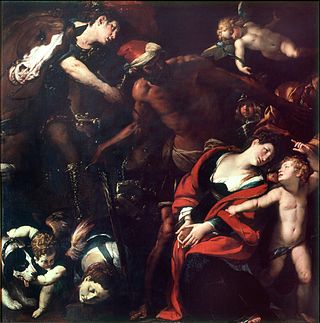
Rufina and Secunda were Roman virgin-martyrs and Christian saints. Their feast day is celebrated on 10 July.
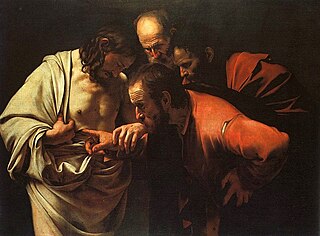
A number of people have claimed to have had visions of Jesus Christ and personal conversations with him. Some people make similar claims regarding his mother, Mary. Discussions about the authenticity of these visions have often invited controversy. The Catholic Church endorses a fraction of these claims, and various visionaries it accepts have achieved beatification, or even sainthood.

The Archdiocese of Cebu is a Latin Church archdiocese of the Catholic Church in the Philippines and one of the ecclesiastical provinces of the Catholic Church in the country. It is composed of the entire civil province of Cebu. It is the Mother Church of the Philippines. The jurisdiction, Cebu, is considered as the fount of Christianity in the Far East.
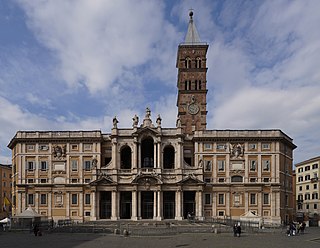
Catholic Marian churches are religious buildings dedicated to the veneration of the Blessed Virgin Mary. These churches were built throughout the history of the Catholic Church, and today they can be found on every continent including Antarctica. The history of Marian church architecture tells the unfolding story of the development of Catholic Mariology.

The Roman Catholic Diocese of Vasai is a diocese located in the city of Vasai in the ecclesiastical province of Bombay in India.
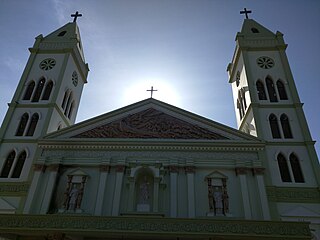
St. Stephen's Church is a Roman Catholic church dedicated to Saint Stephen, located in the village of Kombuthurai in the Thoothukudi district of Tamil Nadu, India. The church was built by St. Francis Xavier in May 1544. It was abandoned by the Jesuits until 1983. The church was taken care of by a people called the "Patangatins/Pattamkattins", according to the wished of St. Francis Xavier, who believed that they could take care of the work of Christianity in Thoothukudi as written in his letters.

Saint Peter, also known as Peter the Apostle, Simon Peter, Simeon, Simon, or Cephas, was one of the Twelve Apostles of Jesus Christ and one of the first leaders of the early Christian Church. He appears repeatedly and prominently in all four New Testament gospels as well as the Acts of the Apostles.

In the Catholic Church, a basilica is a designation given by the Pope to a church building, conferring special privileges. Basilicas are distinguished for ceremonial purposes from other churches. The building need not be a basilica in the architectural sense. Basilicas are either major basilicas – of which there are four, all in the Diocese of Rome – or minor basilicas, of which there were 1,810 worldwide as of 2019.

Our Lady of Purification Church also known as the Port Kollam Church is a historic Roman Catholic church near Kollam Port in Kollam district of Kerala. According to ecclesiastical tradition the church was established by Thomas the Apostle in 52 CE along with six other churches in Kerala and these churches together are called Ēḻarappaḷḷikaḷ. The church follows Latin Rite and is in the Roman Catholic Diocese of Quilon.

